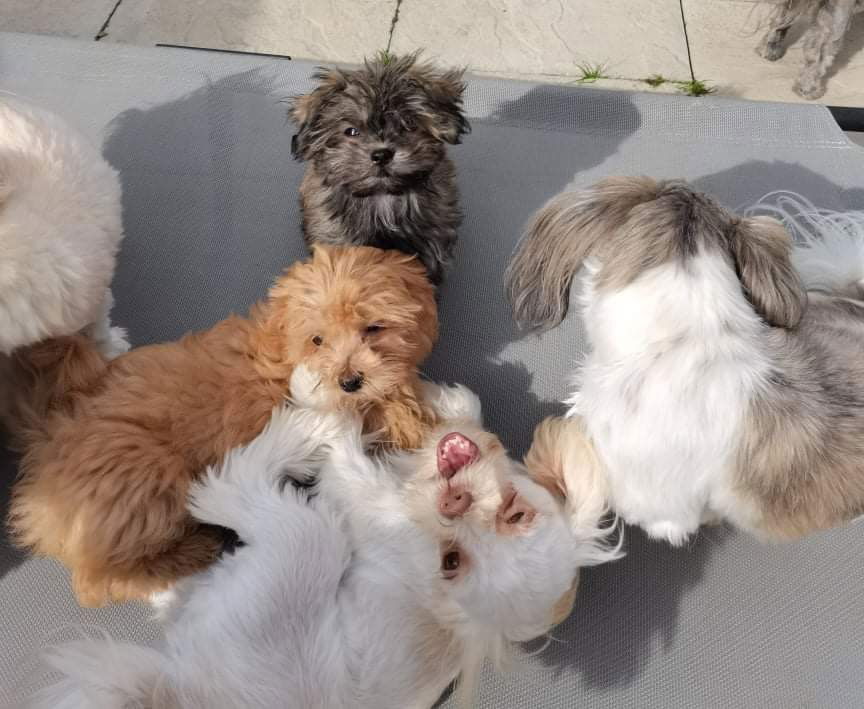Puppy Socialization: Why, When, and How to Do It Right

When to Socialize Your Puppy
During your puppy’s first three months of life, they will experience a socialization period that will permanently shape their future personality and how they will react to their environment as an adult dog. Gently exposing them to a wide variety of people, places, and situations now makes a huge, permanent difference in their temperament. When you buy a puppy from a responsible breeder, the socialization process should start before you even bring your pet home. Gentle handling by the breeder in the first several weeks of your puppy’s life is helpful in the development of a friendly, confident dog. As early as three weeks of age, puppies may begin to approach a person who is passively observing them, so having a knowledgeable breeder who encourages a positive experience with people – adults and children — will help shape the puppy’s adult behavior. As their puppies develop, good breeders allow them to experience safe inside and outside environments, car rides, crates, sounds, and smells.
Why Socialize Your Puppy
The idea behind socialization is that you want to help your puppy become acclimated to all types of sights, sounds, and smells in a positive manner. Proper socialization can prevent a dog from being fearful of children, for example, or of riding in a car. It will help them develop into a well-mannered, happy companion. Having a dog who is well-adjusted and confident can even go as far as to save their life one day, improper socialization can lead to behavior problems later in life. Start taking your dog out to public places once your veterinarian says it is safe, and they will learn how to behave in a variety of situations and to enjoy interacting with different people.
How to Socialize Your Puppy
As mentioned earlier, your breeder will start the socialization process. When the puppy comes home with you, your job is to keep the process going. Here are basic steps to follow:
- Introduce the puppy to new sights, sounds, and smells: To a puppy, the whole world is new, strange, and unusual, so think of everything they encounter as an opportunity to make a new, positive association. Try to come up with as many different types of people, places, noises, and textures as you can and expose your puppy to them. That means, for instance, having them walk on carpet, hardwood, tile, and linoleum floors, meet a young and old person, someone in a wheelchair or using a cane, a person with a beard, wearing sunglasses or a hood, and using an umbrella. Think of it as a scavenger hunt.
- Make it positive: Most importantly, when introducing all of these new experiences to your puppy, make sure they are getting an appropriate amount of treats and praise. As a result, the pet will associate what they are being exposed to with the feeling of seeing something new being a fun experience. Break treats into small pieces that will be easy for your puppy to digest. Also, try to remain calm — dogs can read our emotions. So if you are nervous when introducing your puppy to an older dog, for example, your pet will be nervous, too, and may become fearful of other dogs in the future.
- Involve the family: By having different people take part in the socialization process, you continuously move the puppy out of their comfort zone. That lets the dog know that they might experience something new, no matter who they are with. Make it a fun game for kids by having them write down a list of everything new the puppy experienced that day while with them, such as “someone in a baseball cap” or “a police siren.”
- Take baby steps: Try to avoid doing too much, too fast. For instance, if you want your puppy to get accustomed to being handled by multiple people they do not know, start with a few family members and slowly integrate one stranger, then two, and so on. Starting this process by taking your puppy to a huge party or a very busy public place can be overwhelming and result in a fearful response to groups of strangers in the future.
- Take it public: Once your puppy is used to a small amount of stimuli, move outside of their comfort zone and expand the amount of new experiences he’ll have. Take them to the pet store (after they have started their vaccination series), over to a friend’s house for a canine playdate, on different streets in the neighborhood, and so on. At 7 to 10 days after the dog has received their full series of puppy vaccinations, you can safely take them to the dog park (but be sure to follow dog-park safety protocol.)
- Go to puppy classes: Once your puppy has started vaccinations, they can also attend puppy classes. These classes not only help your pet begin to understand basic commands, but they also expose them to other canines and people. Skilled trainers will mediate the meetings so that all dogs and people are safe and happy during the process.
What About Older Dogs?
All of this information on how important socialization is for puppies brings up the question: what about older dogs? If you have acquired an adult dog, you can still help them associate new or fearful situations with positive experiences, even though you have missed the crucial puppy socialization period. Slowly reintroducing the canine to new sights, smells, and sounds, with careful supervision and an emphasis on positivity in the form of praise and treats, can help them overcome fears or hesitation. (Severe cases of fearfulness should be treated with the help of a veterinarian and/or animal behaviorist.)


